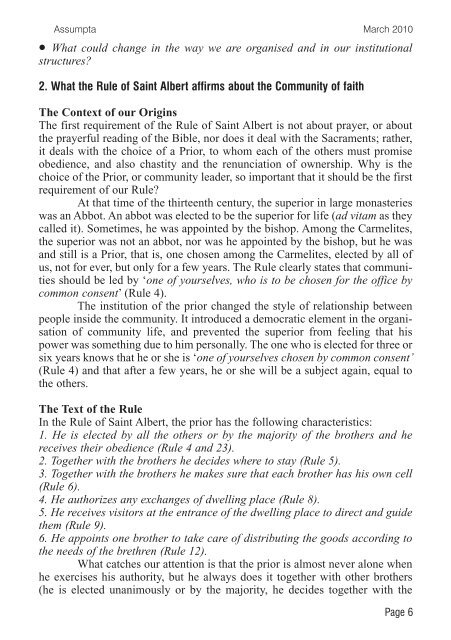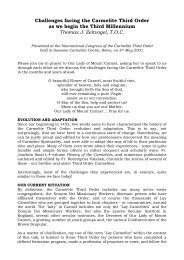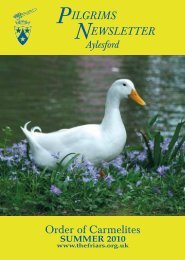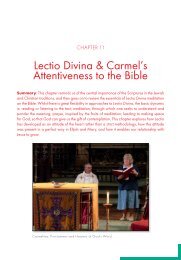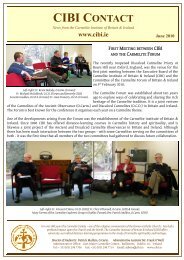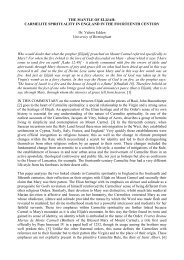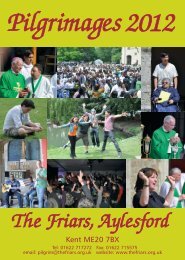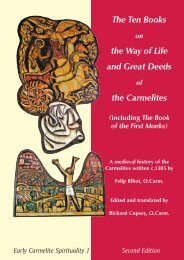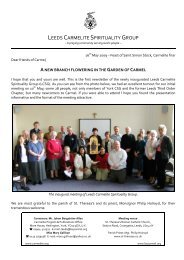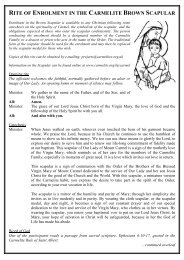Assumpta - British Province of Carmelite Friars
Assumpta - British Province of Carmelite Friars
Assumpta - British Province of Carmelite Friars
You also want an ePaper? Increase the reach of your titles
YUMPU automatically turns print PDFs into web optimized ePapers that Google loves.
<strong>Assumpta</strong> March 2010<br />
• What could change in the way we are organised and in our institutional<br />
structures<br />
2. What the Rule <strong>of</strong> Saint Albert affirms about the Community <strong>of</strong> faith<br />
The Context <strong>of</strong> our Origins<br />
The first requirement <strong>of</strong> the Rule <strong>of</strong> Saint Albert is not about prayer, or about<br />
the prayerful reading <strong>of</strong> the Bible, nor does it deal with the Sacraments; rather,<br />
it deals with the choice <strong>of</strong> a Prior, to whom each <strong>of</strong> the others must promise<br />
obedience, and also chastity and the renunciation <strong>of</strong> ownership. Why is the<br />
choice <strong>of</strong> the Prior, or community leader, so important that it should be the first<br />
requirement <strong>of</strong> our Rule<br />
At that time <strong>of</strong> the thirteenth century, the superior in large monasteries<br />
was an Abbot. An abbot was elected to be the superior for life (ad vitam as they<br />
called it). Sometimes, he was appointed by the bishop. Among the <strong>Carmelite</strong>s,<br />
the superior was not an abbot, nor was he appointed by the bishop, but he was<br />
and still is a Prior, that is, one chosen among the <strong>Carmelite</strong>s, elected by all <strong>of</strong><br />
us, not for ever, but only for a few years. The Rule clearly states that communities<br />
should be led by ‘one <strong>of</strong> yourselves, who is to be chosen for the <strong>of</strong>fice by<br />
common consent’ (Rule 4).<br />
The institution <strong>of</strong> the prior changed the style <strong>of</strong> relationship between<br />
people inside the community. It introduced a democratic element in the organisation<br />
<strong>of</strong> community life, and prevented the superior from feeling that his<br />
power was something due to him personally. The one who is elected for three or<br />
six years knows that he or she is ‘one <strong>of</strong> yourselves chosen by common consent’<br />
(Rule 4) and that after a few years, he or she will be a subject again, equal to<br />
the others.<br />
The Text <strong>of</strong> the Rule<br />
In the Rule <strong>of</strong> Saint Albert, the prior has the following characteristics:<br />
1. He is elected by all the others or by the majority <strong>of</strong> the brothers and he<br />
receives their obedience (Rule 4 and 23).<br />
2. Together with the brothers he decides where to stay (Rule 5).<br />
3. Together with the brothers he makes sure that each brother has his own cell<br />
(Rule 6).<br />
4. He authorizes any exchanges <strong>of</strong> dwelling place (Rule 8).<br />
5. He receives visitors at the entrance <strong>of</strong> the dwelling place to direct and guide<br />
them (Rule 9).<br />
6. He appoints one brother to take care <strong>of</strong> distributing the goods according to<br />
the needs <strong>of</strong> the brethren (Rule 12).<br />
What catches our attention is that the prior is almost never alone when<br />
he exercises his authority, but he always does it together with other brothers<br />
(he is elected unanimously or by the majority, he decides together with the<br />
Page 6


